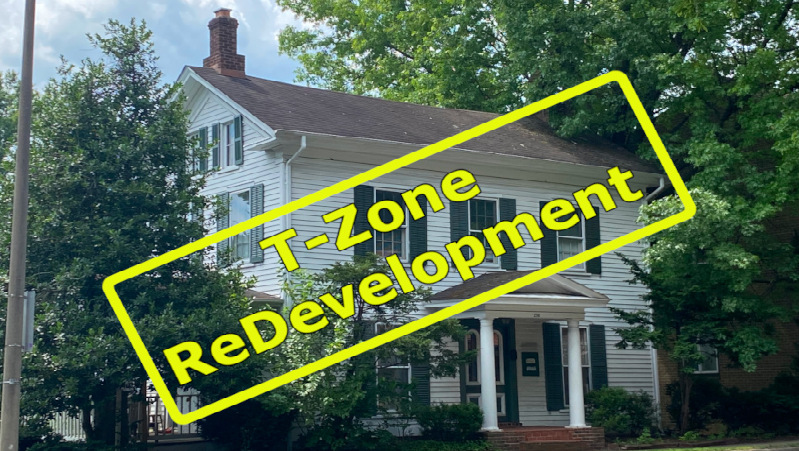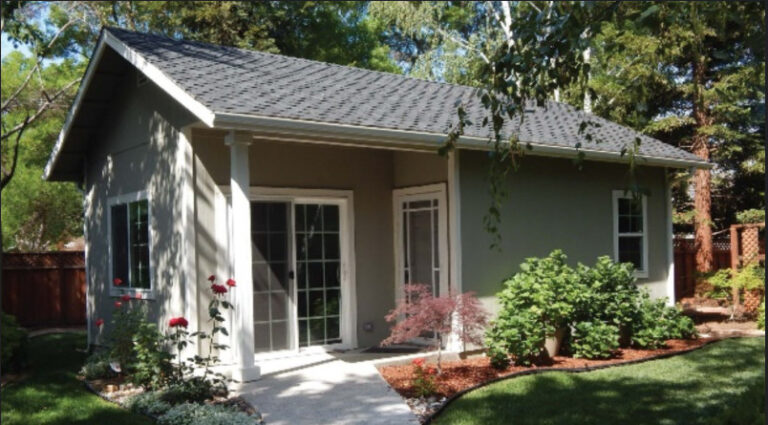Evolution Of T-Zone Proposals
Author: Edith Snyder
Falls Church City Council approves developer-friendly T-Zone legislation favoring greater building density at the expense of the environment and meaningful oversight
The chart below tracks revisions to the current transition zone (T-Zone) ordinance since the City Council’s 5-2 decision on May 23, 2022, to approve proposed changes on first reading. Included here are the Planning Commission’s February 15, 2023, recommendations to the Council as well as City planning staff’s suggested amendments on April 24, 2023, June 5, 2023, July 10, 2023, and August 7, 2023.
On August 7, the City Council again voted 5-2 to approve a new first reading based on the most recent staff proposal after amending it to eliminate one of the few concessions to citizen input by allowing developers the “flexibility” to reduce front-yard setbacks. The Planning Commission will meet later this month to review the proposed ordinance and make recommendations for any changes. The Council has scheduled September 11, 2023, for a second reading and enactment of this legislation.
More Density
The June 5 planning staff recommendations introduced an entirely new way of describing what can be built (units per acre) and the processes for approving new development (acreage involved). The July 10 and August 7 staff recommendations further increased the density that would be permitted per acre in T-1 lots based on the new units-per-acre concept.
- June 5: 8-20 units/acre (permits 1 quad or 2 duplexes per ½ acre, minimum)
- July 10: 14-30 units/acre (permits 1 quad per ¼ acre, minimum)
- August 7: 14-34 units/acre if no affordable dwelling units (ADUs), or 40 units/acre, if 10% ADUs (both by right), or 60 units/acre if density bonus ADUs (with Special Use Permit, or SUP)
For townhouses, which the community prefers, the June 5 proposal permitted up to double the number of townhouses/acre as are currently allowed. The July 10 proposal allowed up to triple the number of townhouses/acre. The latest August 7 figures quadruple what is now permitted, by-right, or six times as many townhouses with bonus ADUs. There is no staff discussion of the question: How many townhouses would logically fit, or is the developer effectively forced into condo/apartment construction at the higher unit numbers? The report offers no explanation for the logic behind these figures.
In addition, despite a well-attended Planning Commission listening session November 2, 2022, similarly packed community question-and-answer sessions on February 9, and March 21, 2023, and ongoing comments and recommendations for improving this ordinance, citizen concerns regarding building height, lot coverage, setbacks and step-backs, trees, stormwater, and affordable housing were ignored. Protections for historic structures on T-1 properties will require another ordinance not yet on the drawing board.
Less Oversight
The Council also ceded its oversight responsibility to developers by increasing by-right building heights from 40 to 45 feet and 4 stories and maximum density per acre from 30 units to up to 40 units. Builders would have complete discretion; all that would be required of them is approval of their Grading Plans by City staff (if the development is 9,000 square feet or less) or Site Plans by the Planning Commission (if the development is more than 9,000 square feet).
The City Council would not intervene unless a developer proposes to exceed height and setback restrictions or to entertain an ADU bonus density greater than 20%. Further, no benefits to the City—for example, additional money for schools, parks, or public services—would be negotiated as they have been under the legislated Special Exception process that the Council has used to guide mixed-use development in Falls Church for the last 20 years.
Documents used in creating this chart are cited below. Previous posts on the T-Zone Proposal are available here. They include building renditions and comments from council members, planning commissioners and the public on this issue.
Evolution of T-Zone Proposals Chart
References:
- For an overview of the T-zone proposal read our T-Zone Primer.
- August 7, 2023 Planning Staff Report, (TO23-11) Ordinance to Amend Chapter 48 “Zoning” to Include an Average Unit Size and Density Restrictions in the T-1 Transition Zone; Eliminate Single Family and Two Family residential Use Therein; Allow for a Townhouse, Apartment and Condo option and Allow for Expanded Lot Coverage https://fallschurch-va.granicus.com/MetaViewer.php?view_id=2&event_id=2036&meta_id=124155
- July 10, 2023 Planning Staff Report, Ordinance to Amend Chapter 48 “Zoning” to Include an Average Unite size and Density Restrictions in the T-1 Transition Zone; Eliminate Single Family and Two Family Residential Use Therein; Allow for a Townhouse, Apartment, and Condo Option and Allow for Expanded Lot Coverage https://fallschurch-va.granicus.com/MetaViewer.php?view_id=2&event_id=1362&meta_id=123364
- June 5, 2023 Planning Staff Report, Review of Revised Concept for Update of Transitional (T) Zones https://fallschurch-va.granicus.com/MetaViewer.php?view_id=2&clip_id=2321&meta_id=122416
- April 24, 2023 Planning Staff Report, Ordinance to Amend Chapter 48 “Zoning” to Combine Transitional Districts; Eliminate Single Family and Two Family Residential Use Therein; Allow for a Townhouse, Apartment and Condo Option and Allow for Expanded Lot Coverage https://fallschurch-va.granicus.com/MetaViewer.php?view_id=2&clip_id=2267&meta_id=120978
- March 6, 2023 Planning Staff Report, Ordinance to Amend Chapter 48 “Zoning” to Combine Transitional Districts; Eliminate Single Family and Two Family Residential Use Therein; Allow for a Townhouse, Apartment and Condo Option and Allow for Expanded Lot Coverage https://fallschurch-va.granicus.com/MetaViewer.php?view_id=2&clip_id=2214&meta_id=118726
- February 15, 2023 Planning Commission Recommendations, Ordinance to Amend Chapter 48 “Zoning” to Combine Transitional Districts; Eliminate Single Family and Two Family Residential Use Therein; Allow for a Townhouse, Apartment and Condo Option and Allow for Expanded Lot Coverage https://fallschurch-va.granicus.com/MetaViewer.php?view_id=2&clip_id=2181&meta_id=118271







